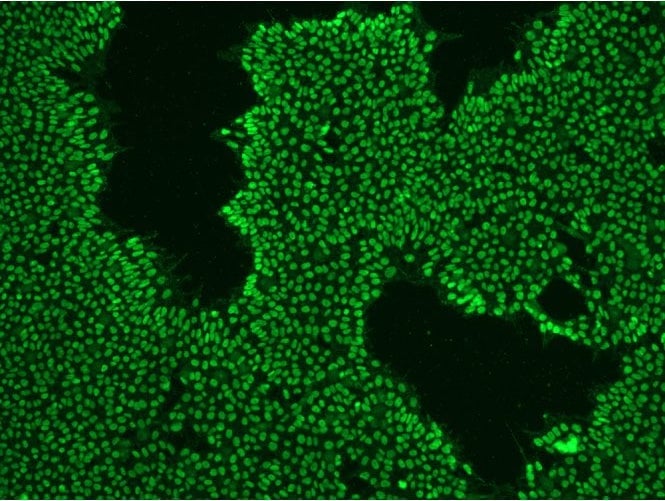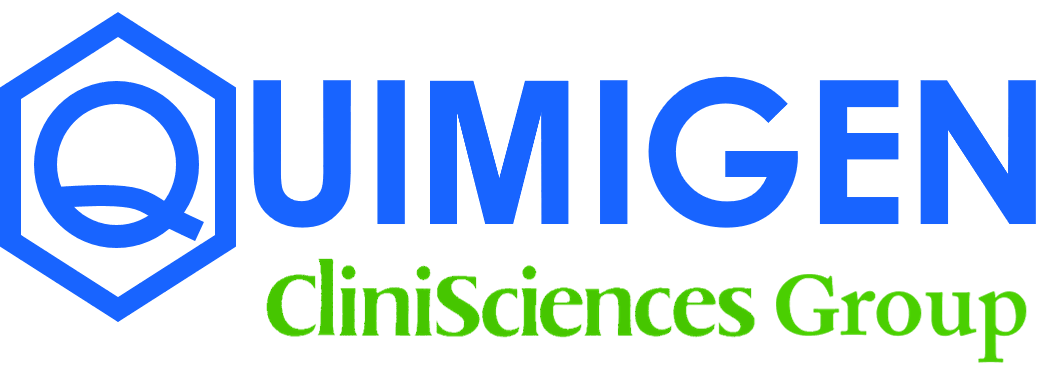StemAb Antibody (Affinity Purified), Rabbit anti-Mouse/Human
09-0023
Brand: StemAB
Rabbit anti-mouse/human antibody to Oct 4, associated with an undifferentiated phenotype in PSCs. Used for demonstrating pluripotency.

Currency:
Note: shown do not include shipping and handling charges.
Product Information

Immunocytochemistry analysis of Oct4 on H1 human ES cells. Cells were treated with StemAb Oct4 Antibody (Affinity Purified) using a 1:100 dilution followed by a secondary Cy3 conjugated antibody (red). DAPI staining was performed to visualize nuclei (blue).

Flow cytometry analysis of Oct4 on H1 human ES cells. Purple histogram represents Oct4 Antibody and open histogram represents isotype control at the same concentration.
StemAb brand name is the property of REPROCELL Inc., Japan.
- Looijenga, L.H., Stoop, H., de Leeuw, H.P., de Gouveia Brazao, C.A., Gillis, A.J., van Roozendaal, K.E., van Zoelen, E.J., Weber, R.F., Wolffenbuttel, K.P., van Dekken, H., Honecker, F., Bokemeyer, C., Perlman, E.J., Schneider, D.T., Kononen, J., Sauter, G., Oosterhuis, J.W. POU5F1 (OCT3/4) identifies cells with pluripotent potential in human germ cell tumors. Cancer Res 63: 2244-2250(2003).
- Zaehres, H., Lensch, M.W., Daheron, L., Stewart, S.A., Itskovitz-Eldor, J., Daley, G.Q. High-efficiency RNA interference in human embryonic stem cells. Stem Cells 23: 299-305(2005).
- Takahashi, K., and Yamanaka, S. Induction of pluripotent stem cells from mouse embryonic and adult fibroblast cultures by defined factors. Cell 126, 663-676(2006).
- Takahashi, K., Tanabe K., Ohnuki, M., Narita, M., Ichisaka T., Tomoda K. and Yamanaka, S. Induction of pluripotent stem cells from adult human fibroblasts by defined factors. Cell 131: 861-872(2007).
- Park, I.H., Arora, N., Huo, H., Maherali, N., Ahfeldt, T., Shimamura, A., Lensch, M.W., Cowan, C., Hochedlinger, K., and Daley, G.Q. Disease-specific induced pluripotent stem cells. Cell 134: 877-886(2008).
Additional Publications
- Völkner C; Liedtke M; Patters J; Lukas J; Escobar HM; Knuebel G; Bullerdiek J; Holzmann C; Hermann A; Frech MJ. Generation of an iPSC line (AKOSi004-A) from fibroblasts of a female adult NPC1 patient, carrying the compound heterozygous mutation p.Val1023Serfs*15/p.Gly992Arg and of an iPSC line (AKOSi005-A) from a female adult control individual. Stem Cell Res 50:102127 (2021).
- Völkner C; Liedtke M; Petters J; Huth K; Knuebel G; Escobar HM; Bullerdiek J; Lukas J; Hermann A; Frech MH. Generation of an iPSC line (AKOSi006-A) from fibroblasts of a NPC1 patient, carrying the homozygous mutation p.I1061T (c.3182 T > C) and a control iPSC line (AKOSi007-A) using a non-integrating Sendai virus system. Stem Cell Res 49:102056 (2020).
- Fukunaga I; Shirai K; Oe Y; Danzaki K; Ohta SZ; Shiga T; Chen C; Ikeda K; Akamatsu W; Kawano A; Kamiya K. Generation of two induced pluripotent stem cell lines from PBMCs of siblings carrying c.235delC mutation in the GJB2 gene associated with sensorineural hearing loss. Stem Cell Res 47:101910 (2020).
- Wang K; Lin R-Z; Hong X; Ng AH; Lee CN; Neumeyer J; Wang G; Wang X; Ma M; Pu WT; Church GM; Melero-Martin JM. Robust differentiation of human pluripotent stem cells into endothelial cells via temporal modulation of ETV2 with modified mRNA. bioRxiv :https://doi.org/10.1101/2020.03.02.973289 (2020).
- Koutmani Y; Gampierakis IA; Polissidis A; Ximerakis M: Koutsoudaki PN; Polyzos A; Agrogiannis G; Karaliota S; Thomaidou D; Rubin LL; Politis PK; Karakis KP. CRH Promotes the Neurogenic Activity of Neural Stem Cells in the Adult Hippocampus. Stem Cell Rep 28:932-945.e7 (2019).
- McGrath M; Tam E; Sladkova M; AlManaie A; Zimmer M; de Peppo GM. GMP-compatible and xeno-free cultivation of mesenchymal progenitors derived from human-induced pluripotent stem cells. Stem Cell Res Therap 10:411 (2019).
- Wang L; De Solis AJ; Goffer Y; Birkenback KE; Engle SE; Tanis R; Levenson JM; Lu X; Rausch R: Purohit M; Lee J-Y; Tan J; De Rosa MC; DOege CA; Aaron HL; Martins G; Brüning JC; Egli D; Costa R; Berbari N; Leibel RL; Stratigopoulos G. Ciliary gene RPGRIP1L is required for hypothalamic arcuate neuron development. JCI Insight 4:e123337 (2019).
- Baumann H; Jahn M; Muenchau A; Trilck-WInkler M; Lohmann K; Seibler P. Generation and characterization of eight human-derived iPSC lines from affected and unaffected THAP1 mutation carriers. Stem Cell Res 33:60-64 (2018).
- Sevilla A; Forero E; Zimmer M; Martinez H; Reggio K; Paull D; Egli D; Noggle S. Derivation and characterization of the NIH registry human stem cell line NYSF100 line under definde feeder-free conditions. Stem Cell Research 29:99 (2018).
- Yucer N; Holzapfel M; Jenkins Vogel T; Lenaeus L; Ornelas L; Laury A; Sareen D; Barrett R; Karlan BY; Svendsen CN. Directed Differentiation of Human Induced Pluripotent Stem Cells into Fallopian Tube Epithelium. Sci Rep 7:10741 (2017).
- Um S; Lee H; Zhang Q; Kim HY; Lee J-H; Seo BM. Valproic acid modulates the mutlipotency in peridontal ligament stem cells via p53-mediated cell cycle. Tissue Engineering Regenerative Medicine 2:153 (2017.)
- Sevilla A; Forero E; Zimmer M; Martinez H; Reggio K; Paull D; Egli D; Noggle S. Derivation and characterization of the NYSCFe003-A human embryonic stem cell line. Stem Cell Res 25:217-220 (2017).
- Burnett LC; LeDuc CA; Sulsona CR; Paull D; Eddira S; Levy B; Salles JP; Tauber M; Driscoll DJ; Egli D; Leibel RL. Induced pluripotent cells (iPSC) created from skin fibroblasta of patients with Prader-Willi syndrome (PWS) retain the molecular signature of PWS. Stem Cell Res 17:526-530 (2016.)
- Sridhar A; Ohlemacher SK; Langer KB; Meyer JS. Robust differentiation of mRNA-reprogrammed human induced pluripotent stem cells toard a retinal lineage. Stem Cell Translational Medicine 5:10 (2016).
- Ohlemacher SK; Sridhar A; Xiao Y; Hochstetler AE; Sarfarazi M; Cummins TR; Meyer JS. Stepwise differentiation of retinal ganglion cells from human pluripotent stem cells enables analysis of glaucomatous neurodegeneration. _Stem Cells_34:1553 (2016).
- Cieslar-Pobuda A; Rafat M; Knoflach V; Skonieczna M; Hudecki A; Malechi A; Urasinska E; Ghavami S; Los MJ. Human induced pluripotent stem cell differentiation and direct transdifferentiatoin into corneal epithelial-like cells. Oncotarget 7:42314 (2016).
- Poleganov MA; Eminli S; Beissert T; Herz S; Moon J-I; Goldmann J; Beyer A; Heck R; Burkhart I; Roldan DB; Tureci O; Yi K; Hamilton B; Sahin U. Efficient reprogramming of human fibroblasts and blood-derived endothelial progenitor cells using nonmodified RNA for reprogramming and immune evasion. Human Gene Therapy 26:751 (2015).
- Han F; Wang W; CHen B; CHen C; LI Sen; Lu X; Duan J; Zhang Y; Zhang YA; Guo W; Li G. Human induced pluripotent stem cell-derived neurons improve motor asymmetry in a 6-hydroxydopamine-induced rat model of Parkinson's disease. Cytotherapy 17:665 (2015).
- Paull D; Sevilla A; Zhou H; Hahn AK; Kim H; Napolitano C; Tsankov A; Shang L; Krumholz K; Jagaseesan P; Woodard CM; Sun B; Vilboux T; Zimmer M; Forero E; Moroziewicz DN; Martinez H; Malicdan MCV; Weiss KA; Vensand LB; Dusenberry CR; Polus H; Sy KTL; Kahler DJ; Gahl WA; Solomon SL; Chang S; Meissner A; Eggan K; Noggle SA. Automated, high-throughput derivation, characterization and differentiation of induced pluripotent stem cells. Nature Methods 12:885 (2015).
- Ren J; Briones V; Barbour S; Yu W; Han Y; Tarashima M; Muegge K. The ATP binding site of the chromatin remodeling homolog LSH is required for nucleosome density and de novo DNA methylation at repeat sequences. Nucl Acids Res 43:1444 (2015).



